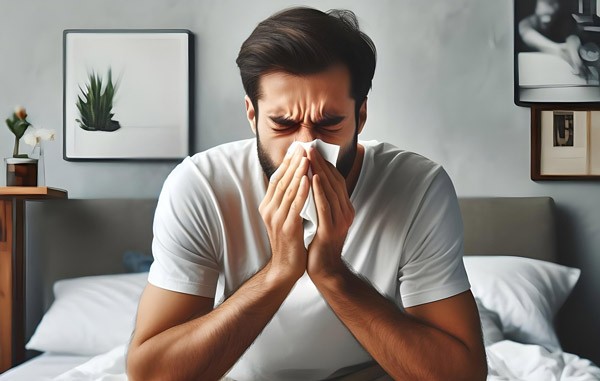Has the novel coronavirus hit multiple places? Take good precautions to keep respiratory infectious diseases at bay!
发布时间:2025-05-23 16:46:01来源:互联网
According to the latest testing data released by the Chinese Center for Disease Control and Prevention, the positive rate of the novel coronavirus among influenza-like cases in outpatient and emergency departments across the country rose to 16.2% in April, ranking first among respiratory viruses for three consecutive weeks and even surpassing influenza and rhinoviruses. What is more concerning is that the positive rate of COVID-19 among hospitalized cases is also on the rise, and the infection rate in some southern provinces is even higher than that in the north.
So, what are the characteristics of this round of COVID-19 infections? Will it cause a large-scale infection like in 2019? Now, let Hong Kong Times Medical provide you with a detailed answer!

The characteristics of this round of COVID-19 infection: stronger immune escape ability and symptoms more like a cold
Hong Kong Times Medical stated that the currently prevalent novel coronavirus is mainly the XDB variant and its sub-variant NB.1.8.1, which belong to the Omicron family and are the "recombinant descendants" of JN.1 and XDE. Although they are not entirely new strains, they have stronger adaptability, which increases the difficulty of protection.
Feature One: Stronger immune escape
Compared with previous strains of the novel coronavirus, the XDB variant can more effectively bypass the existing immune defense of the human body, which means that even if one has been infected with the novel coronavirus or vaccinated against it before, it is still possible to be infected again.
Feature Two: The symptoms are more like a cold
For most people, the symptoms of this round of infection are more similar to those of a common cold, mainly including coughing, sore throat, low fever and nasal congestion. However, high-risk groups such as children, people aged 60 and above, those with underlying diseases (diabetes, cardiovascular and cerebrovascular diseases, chronic obstructive pulmonary disease, etc.), and people with weakened immune systems (such as those undergoing tumor treatment or organ transplantation) may still suffer serious consequences after infection. Therefore, protection cannot be relaxed!
Feature 3: The dissemination power remains undiminished
So, how long will this wave of COVID-19 infections last? In fact, there have always been periodic peaks in COVID-19 infections in the past. This "rebound" is not a sudden new outbreak, but rather a regular small peak of the epidemic caused by factors such as seasonal changes and holidays. Therefore, based on previous data, it is expected that this round of small peak will gradually ease from the end of May to the middle and late June.
Apart from COVID-19, other respiratory tracts are also on the rise...
According to the monitoring data from the Center for Disease Control and Prevention, in addition to the novel coronavirus, there are also many other respiratory viruses that are currently prevalent, and the infection symptoms of these respiratory diseases are very similar. Therefore, citizens need not be overly anxious. They just need to face it calmly, provide reasonable and targeted care and medication, and seek medical attention promptly when necessary.
At the same time, in the face of the rampant spread of various respiratory infectious diseases, it is also very important to do a good job in daily protection, which includes:
1. Daily protection: Build the first line of defense
Wash hands frequently: Teach children to wash their hands with soap and running water for at least 20 seconds, especially after coughing or sneezing.
Reduce touching of eyes, mouth and nose: The virus can enter the body through mucous membranes. It is necessary to remind children to avoid rubbing their eyes and biting their fingers.
Wearing masks: Wear children's masks of appropriate size in crowded places such as hospitals and public transportation.
2. Environmental Management: Creating a safe living space
Keep the room well-ventilated: Open Windows 2 to 3 times a day for 30 minutes each time to reduce the concentration of viruses indoors.
Regular disinfection: Frequently touched areas such as door handles, toys, and tabletops can be wiped with alcohol or chlorine-containing disinfectants.
Avoid cross-infection: If there are people with respiratory symptoms at home, they should be isolated as much as possible and avoid close contact with children.
3. Boost immunity: Adopt a dual approach of nutrition and exercise
Balanced diet: Consume more foods rich in vitamin C(citrus fruits) and zinc (nuts, lean meats).
Adequate sleep: School-aged children should ensure 9 to 12 hours of sleep every day, which is beneficial for the repair of the immune system.
Moderate exercise: Engage in outdoor activities for one hour every day to enhance physical fitness, but avoid catching a cold after intense exercise.
The novel coronavirus is still mutating, but over the past few years, we have accumulated considerable experience in dealing with it. Therefore, whether it is novel coronavirus infection or other respiratory infectious diseases, as long as we do a good job in scientific protection and reasonable care, we can build an impregnable "wall" for health and keep them out.

免责声明
【慎重声明】 凡本站未注明来源为“默认站点”的所有作品,均转载、编译或摘编自其它媒体,转载、编译或摘编的目的在于传递更多信息,并不代表本站赞同其观点和对其真实性负责。 如因作品内容、版权和其他问题需要同本网联系的,请在30日内进行!
最新文章
- 黄金主轴“城”启大汉口|行业媒体大咖交流会圆满落幕
- Beijing MOCA Grand Opening
- Fuzhou, Jiangxi, China: Drawing up a blueprint for the big health food industry and creating a new engine for high-quality development
- The National Day Gala of Sanya Silk Road Happy World came to a successful conclusion. "Silk Road Adventure · Autumn Illusion" created a new model of cultural and tourism integration
- 试驾邀约:‘与众淘金季’的隐藏副本等你开启